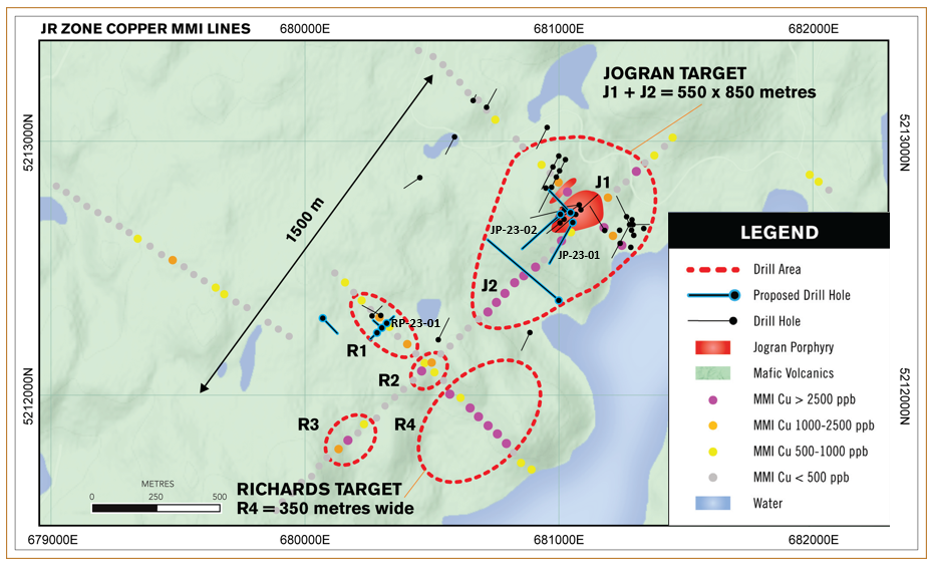Copper Road Resources Inc. has announced the start of the 2023 drill program at the highly promising JR Zone at its Copper Road Project in Batchewana Bay, Ontario. The current drill program is intended to show that the JR Zone has a shallow mineralized porphyry and high-grade breccia in the heart of the company’s district-scale land package, which includes two past-producing copper mines.
 JR Zone MM Lines and Proposed DDHs. Image Credit: Copper Road Resources
JR Zone MM Lines and Proposed DDHs. Image Credit: Copper Road Resources
The JR Zone, which includes the Jogran Porphyry and the neighboring Richards Breccia, is about 12 km from the previous Tribag Mine Zone, which the company drilled in 2022. Copper Road has already undertaken Mobile Metal Ion soil sampling and digitization of past geophysical surveys in the JR Zone (Jogran-Richards) and found the 1.5 km×800 m region is potential for further copper mineralization.
The 1,000-meter summer diamond drilling campaign in 2023 is the first step in establishing the JR Zone as a large-scale zone of profitable copper mineralization at shallow depths.
We are excited about the prospect of identifying an additional large-scale near-surface zone of Cu/Mo/Ag/Au mineralization in the heart of our 21,000-hectare project. Jurisdiction is becoming increasingly important in the modern quest for critical minerals, and our district-scale property in Sault St. Marie, 20 km from the TransCanada Highway, checks all the boxes.
John Timmons, President and Chief Executive Officer, Copper Road Resources
Timmons added, “There have been very few new shallow copper discoveries in Tier-1 jurisdictions in the past decade. Given the potential large scale of the JR Zone, Copper Road is poised to unlock significant value for shareholders, and we look forward to the results from the summer program.”
The following priority targets are being drilled by the company at the JR Zone right now:
- J-P-23-01: The hole will test the Jogran porphyry near two previous DDHs from 1964, JDH-13 (5 to 152 m: 147 m @ 0.27% Cu, 0.068% MoS2, 0.53% Cu Eq) and JDH-16 (5 to 170 m: 165m @ 0.23% Cu, 0.054% MoS2, 0.43% Cu Eq), neither of which were assayed for potential by-product metals (e.g., Au, Ag, Re, W). The 400 m vertical depth of the drill, which is almost double the known deposit’s extent, will be used to test the porphyry mineralization.
- R-P-23-01: The hole will step out approximately 50 m to the west of AR98-07 (27 m @ 1.46% Cu, 0.17 g/t Au, 3.8 g/t Ag) to a vertical depth of around 50 m to test the extent of the past high-grade intercepts in the Richards Breccia. According to the company, the high-grade mineralization is believed to follow the breccia pipe’s perimeter, much like the Breton Breccia, Tribag Mine Zone. The Gradient IP anomaly linked to the Richards Breccia's semi-circular shape supports this.
The J2 “Roof Zone” and the Richards NW chargeability anomaly are two new targets that have more drill holes planned to follow up on, in addition to the visual results of mineralization in the first two proposed holes (J-P-23-01 and R-P-23-01) with step-outs.